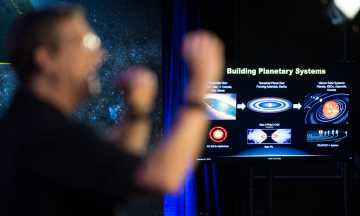Interesting facts about the Kuiper Belt
ShareInteresting facts about the Kuiper Belt

The Kuiper Belt (also known as the Kuiper Belt-Edgeworth) is a region in the form of a disk that is located in the outer solar system, beyond the orbit of Neptune. It extends from the orbit of Neptune at around 30 AU (Astronomical Units) to about 50 AU from the Sun and contains hundreds of millions of small icy bodies that is thought to have been left over material from the formation of the outer planets.
What is the KUIPER belt?
The Kuiper belt is similar to the asteroid belt found between the orbits of Mars and Jupiter, but is 20 times wider, and somewhere between 20-200 times as massive. The ices are volatile frozen that are made up of methane, nitrogen, ammonia, and water.
At least three dwarf planets found in the Kuiper belt: Pluto, Haumea and Makemake. In addition, it is believed that some of the moons in the solar system originated there, such as the Triton of Neptune, and Phoebe of Saturn.
The belt is thick in most places and is described as more in the form of a bull which would be a belt. The Kuiper belt should not be confused with the hypothesized Oort cloud, which is a thousand times more distant.
The objects within the belt, along with the members of the scattered disc and any potential cloud Hill, or objects of Oort cloud are known collectively as trans-neptunian objects (TNO).
Interesting facts Belt KuiperEl Kuiper belt contains millions of icy objects that vary in size, from small lumps of ice up to large objects of 100 km diameter or more.It is estimated that there are around 35,000 objects of strap Deiper that have more than 100 km in diameter. This is several hundred times the number and mass of objects found in the asteroid belt.There can be up to 100 million small objects and weak in the belt, with a diameter of 20 km or less. However, these findings of Anita Cochran and a team of astronomers could not be confirmed by a follow-up observation of the Hubble Space Telescope.
The largest object in the Kuiper belt is the dwarf planet Pluto. Its status as part of the belt is what caused the planet was reclassified as a "dwarf planet" in 2006.
Eris is larger than Pluto, however, lies in the scattered disc - although it is believed that was found originally in the Kuiper belt.
The Triton moon of Neptune is also larger than Pluto and is believed to have been captured from the Kuiper belt due to encounters gravitational.
The first mission to the Kuiper belt and beyond is New Horizons from NASA, which will pass by Pluto in July 2015. Will survey Pluto, Charon and the other moons before continuing its course toward the other objects in the belt and beyond.
There are structures similar to the Kuiper belt around at least nine other stars, according to astronomers. The Hubble Space Telescope observed discs around the stars HD 138664 in the constellation of Lupus, and the constellation of Carina, HD 53143.
What is the KUIPER belt?
The Kuiper belt is similar to the asteroid belt found between the orbits of Mars and Jupiter, but is 20 times wider, and somewhere between 20-200 times as massive. The ices are volatile frozen that are made up of methane, nitrogen, ammonia, and water.
At least three dwarf planets found in the Kuiper belt: Pluto, Haumea and Makemake. In addition, it is believed that some of the moons in the solar system originated there, such as the Triton of Neptune, and Phoebe of Saturn.
The belt is thick in most places and is described as more in the form of a bull which would be a belt. The Kuiper belt should not be confused with the hypothesized Oort cloud, which is a thousand times more distant.
The objects within the belt, along with the members of the scattered disc and any potential cloud Hill, or objects of Oort cloud are known collectively as trans-neptunian objects (TNO).
Interesting facts Belt KuiperEl Kuiper belt contains millions of icy objects that vary in size, from small lumps of ice up to large objects of 100 km diameter or more.It is estimated that there are around 35,000 objects of strap Deiper that have more than 100 km in diameter. This is several hundred times the number and mass of objects found in the asteroid belt.There can be up to 100 million small objects and weak in the belt, with a diameter of 20 km or less. However, these findings of Anita Cochran and a team of astronomers could not be confirmed by a follow-up observation of the Hubble Space Telescope.
The largest object in the Kuiper belt is the dwarf planet Pluto. Its status as part of the belt is what caused the planet was reclassified as a "dwarf planet" in 2006.
Eris is larger than Pluto, however, lies in the scattered disc - although it is believed that was found originally in the Kuiper belt.
The Triton moon of Neptune is also larger than Pluto and is believed to have been captured from the Kuiper belt due to encounters gravitational.
The first mission to the Kuiper belt and beyond is New Horizons from NASA, which will pass by Pluto in July 2015. Will survey Pluto, Charon and the other moons before continuing its course toward the other objects in the belt and beyond.
There are structures similar to the Kuiper belt around at least nine other stars, according to astronomers. The Hubble Space Telescope observed discs around the stars HD 138664 in the constellation of Lupus, and the constellation of Carina, HD 53143.
Keywords: belt, Kuiper, objects, Pluto, Neptune, times, diameter, dwarf, planet, cloud, small, believed, planets, known, moons, form, Space, Triton, Hubble, larger